#Niimi Nishiki
Explore tagged Tumblr posts
Text
youtube
“Ao no Miburo” The First Promo
The official website of Ao no Miburo (The Blue Wolves of Mibu) television anime unveiled a new promotional video. The anime is slated to debut on YTV and NTV in October 2024 at 5:30 p.m.
#ao no miburo#the blue wolves of mibu#shinpachi nagakura#sanosuke harada#keisuke yamanami#heisuke toudou#genzaburou inoue#nishiki niimi#kenji noguchi#juusuke hirama#gorou hirayama#granny#iroha chirinu#anime#anime news#Youtube
1 note
·
View note
Text
Sannan Keisuke and his sword
Sannan Keisuke was a central member of the Shinsengumi when it was first formed and later served as its Vice-Commander. Although he was highly respected by Kondo Isami and Hijikata Toshizo, he was forced to commit seppuku a few years later for desertion from the Shinsengumi headquarters. The reason for his mysterious escape is still unknown. However, there's a theory that the key explanation for escape is hidden in Sannan Keisuke's favorite sword, "Settsu Jyunin Sekishin Okimitsu" (摂州住人赤心沖光). Here, we will introduce an anecdote about the sword that Sannan Keisuke used and his life story, as well as the mystery of his escape from the headquarters, which led to his seppuku.
From a disciple of Kondo Isami to the Vice-Commander of the Shinsengumi
Encounter with Kondo Isami

Sannan Keisuke was born as the second son of the Sannan family, a family of fencing masters in Miyagi Prefecture, Japan, and in his adolescence, he went to Edo to study swordsmanship and jujutsu while pursuing his academic studies.
He studied swordsmanship under Okubo Kurobei, a 900 koku hatamoto who had a dojo in Horidome, Iida-cho, Edo, and learned the Ono-ha Itto style of swordsmanship.
Sannan Keisuke had many exchanges with other schools, often visiting dojos of various swordsmanship styles to compete with them. On one occasion, he fought with Kondo Isami at the Shieikan, a dojo of the Tennen Rishin style, but was defeated.
Sannan Keisuke took advantage of this opportunity to give Kondo Isami a "shirei" (courtesy to a master), and joined his school.
He was a skilled swordsman and rose to the rank of assistant instructor. There are extant records that show that he often went to practice with Kondo Isami and Hijikata Toshizo.
In February 1863, when Kondo Isami was recruited by the Shogunate to join the Roshigumi, Sannan Keisuke also agreed to join. He entrusted an acquaintance with a Chinese poem that stated, "Strive for loyalty with a single sword, even if ten thousand miles of hardship lie in the road ahead", and left for Kyoto together with the rest of the Shieikan.
Becoming Vice-Commander of the Shinsengumi
When Sannan Keisuke and the others arrived in Kyoto, they were informed by Kiyokawa Hachiro, a central figure in the formation of the Roshigumi, that their true purpose was to be the spearhead of the "Sonno Joi" (the idea of respecting the emperor and expelling foreign nations). The formation of the organization was scrapped.
In the meantime, Sannan Keisuke remained in Kyoto with Kondo Isami, Hijikata Toshizo, and others. They relied on the lord of the Aizu Domain (present-day Fukushima Prefecture), Matsudaira Katamori, who served as the governor of Kyoto, to form the Mibu Roshigumi, the predecessor of the Shinsengumi.
From the very beginning of his participation in the Mibu Roshigumi, Sannan Keisuke served in the position of Vice-Commander along with Niimi Nishiki and Hijikata Toshizo. It can be seen that Sannan Keisuke was a central figure in the Shinsengumi from its early days.
The story of his beloved sword "Settsu Jyunin Sekishin Okimitsu"
Sannan Keisuke's favorite sword is one that bears the inscription, "Settsu Jyunin Sekishin Okimitsu-saku". However, this sword was broken in October 1863 during the "Iwaki Masuya Incident" in which Hijikata Toshizo and Sannan Keisuke engaged in combat with the "Futei Roshi (ronin)" (samurai who defied the norms of the regime and started riots, etc.).
The result of this incident was a one-sided victory for the Shinsengumi. At this time, Kondo Isami sent the broken Sekishin Okimitsu, to Edo along with two other badly damaged swords, as evidence of the Shinsengumi's success.
On the other hand, Kondo Isami also wrote in a letter, "Never use a sword from Settsu [Present-day north central Osaka Prefecture and southeastern Hyogo Prefecture]," referring to Sannan Keisuke's beloved sword, which was easily broken.
Disappearance and escape
Changes in position within the Shinsengumi
For his efforts in the Iwaki Masuya Incident, Sannan Keisuke received a reward of 8 ryo (about 1,500,000 yen today) from Matsudaira Katamori, but his presence in the Shinsengumi quickly faded away. In fact, Sannan Keisuke did not participate in the Ikedaya Incident in June 1864, nor in the Kinmon Incident that took place the following month.
In November of the same year, a marching order (行軍録 - kogunroku) was produced by the Shinsengumi in preparation for the conquest of Choshu (present-day Yamaguchi Prefecture), but Sannan Keisuke's name was not in it. This decline in his influence within the Shinsengumi is believed to be one of the reasons for his desertion from the Shinsengumi.
Seppuku due to violation of the Shinsengumi Code
It was around February 21, 1865 (Genji 2/Keio 1) that Sannan Keisuke suddenly escaped from the headquarters, leaving behind a letter. Okita Souji was ordered to pursue him.
Sannan Keisuke was easily found at an inn in Otsu (present-day Otsu City, Shiga Prefecture), and without showing any particular signs of resistance, he was taken back to the headquarters later that day.
The Shinsengumi had a rule called "Kyokuchu-hoto" (a rule that any desertion from the Shinsengumi would be punished with seppuku). When Kondo Isami ordered him to commit seppuku in accordance with this rule, Sannan Keisuke accepted the order with calmness and composure. After exchanging farewell cups of water with his comrades, he was beheaded by Okita Souji.
It's said that the Shinsengumi members and the people of the Mibu area were terribly saddened by the death of Sannan Keisuke, who was a man of learning and character. The reasons for Yamanami's desertion vary from "he couldn't stand the fact that the Shinsengumi was becoming a running dog of the Shogunate" to "he opposed the relocation of the Shinsengumi to Nishi-honganji [Shimogyo-ku, Kyoto] but was ignored," but none of these reasons are confirmed.
The relationship between his beloved sword and his mysterious escape
Who was the swordsmith who forged the Settsu Jyunin Sekishin Okimitsu?
The aforementioned sword was forged by a swordsmith named Sekishin Okimitsu, but this cannot be confirmed by the "Japanese Sword Craftsmanship Encyclopedia" (日本刀工 刀銘大鑑) or the "Japanese Sword Encyclopedia" (日本刀大百科事典), which cover the names of swordsmiths of existing swords.
There are no existing swords, only oshigata, which copied the shape of the Japanese sword on paper. This can be seen at the Kojima Museum (Machida City, Tokyo), which is managed by a descendant of Kojima Shikanosuke, a supporter of the Shinsengumi.
Taking into account the fact that the sword was broken during the Iwaki Masuya incident, that no existing sword has been found, and that the name of the swordsmith has not been handed down, it's questionable whether Sekishin Okimitsu actually existed.
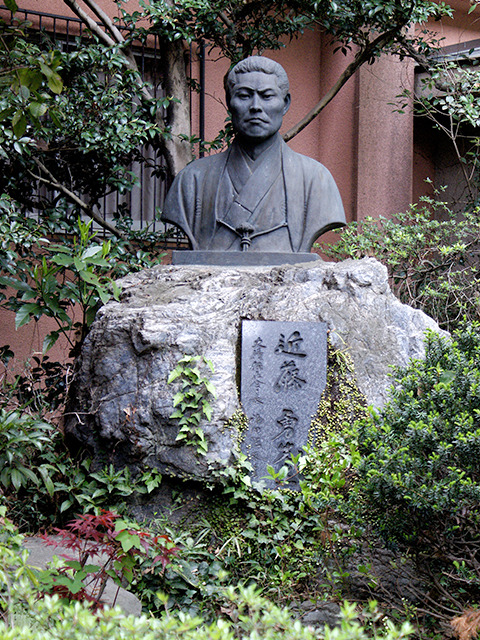
Kojima Museum
The reason why he chose Settsu resident Sekishin Okimitsu as his favorite sword
There are various theories as to why Sannan Keisuke chose this sword, but one of them focuses on the characters "Sekishin" (赤心) inscribed on the sword tang (nakago). Sekishin means "a true heart without lies".
However, when inscribed on a Japanese sword, another meaning is added. It means "loyalty to the emperor". It's believed to have originated from the "Sekishin Hokkoku-tou" (赤心報国刀), a sword used by Asami Keisai, a Confucian scholar in the mid-Edo period who preached "Kino Ushisou" (勤王思想) (The idea of being loyal to the emperor).
In fact, Sannan Keisuke is said to have been a man who was devoted to the ideology of "勤王" (loyalty to the Emperor) and often clashed with Kondo Isami and his followers. The Shinsengumi was formed by presenting a petition to the Aizu Clan, stating that the group would "Protect the Tencho and Taikiko, and expel the barbarians" (天朝並びに大樹公之御守護奉り、攘夷仕るべく候). "Tencho" refers to the Emperor and the Imperial Court, and "Taikiko" refers to the Shogun. However, as time went by, the Shinsengumi shifted away from the original purpose of the organization, moving away from the expulsion of the barbarians and transforming itself into a group that supported only the Shogunate.
Sannan Keisuke chose a sword named after Sekishin as his favorite sword. His refusal to participate in the Ikedaya Incident and the Kinmon Incident, as well as his decision to escape from serving the Shogunate, can be said to reveal his true face as an idealist who stubbornly upheld the principle of "loyalty to the emperor".
17 notes
·
View notes
Photo




I had a small holiday but here’s continuation for character challenges.
#hakuouki#kazama chikage#motoyama kotaro#niimi nishiki#inue genzaburo#shiranui kyo#saito hajime#hijikata toshizo#okita souji#kazama thinks very simple#I hoped I could have done better motoyama but I hardy know anything about him#I enjoyed niimi this time#scared little man..#would rather drink ochimizu than take responsibility#inue was very easy#he really is the most reasonable out of the shinsengumi#treated chizuru kindest too at the beginning#the reliable father/uncle figure for everyone#character challenge#fan art#chibi
54 notes
·
View notes
Photo

#uss enterplaid#serizawa kamo#niimi nishiki#hijikata toshizo#kondo isami#sannan keisuke#hakuouki#katchan loves haiqueue man
16 notes
·
View notes
Photo







A screencap tribute to Koudou and Niimi from Reimeiroku
Source: hakumyu-fancom.livejournal.com
0 notes
Photo




They’re so cute when they’re petty. (Not Serizawatachi, but the rest of ‘em.)
8 notes
·
View notes
Text
---- : shinsengumi ranks : ----

Now that we have gain two ( three ) new Shinsengumi members, it’s time to get cracking on who’s the top and who’s the bottom of the Shinsengumi ladder and how to PROPERLY address these Servants accordingly to their ranks back during their active days.
C O M M A N D E R
In the SHINSENGUMI history, there is only one person that holds this position and that would be Kondo Isami. Formerly, Serizawa Kamo was also a Commander of them alongside with Kondo but this was during their days as Roshigumi before Katamori of Aizu declared them as the Shinsengumi.
Despite being assassinated, Serizawa Kamo is still considered Commander of the Shinsengumi along side with Kondo Isami in records. Nobody in the Shinsengumi approves of Serizawa’s habits and actions but almost everybody respected him as he has a certain charisma as well having strong conviction that he and the Roshigumi were going to change the country.
Lower rank members call Serizawa as sensei and others refer to him as “san”. Hijikata included refers to Serizawa as “Serizawa-san” during their time together. Nagakura Shinpachi, who comes from the same SCHOOL as Serizawa stated at his funeral that the country has loss a great man. Though if only his habits and short temper did not get in the way.
V I C E C O M M A N D E R
We al know who that is, our lovely and infamous Demon Vice-Commander Hijikata Toshizo. This rank is the second in command for the Shinsengumi and Hijikata being Kondo’s right hand man for all matters for the Shinsengumi. Though apparently, everybody goes to Hijikata for problems relating to their work while Kondo handles more of the political side of things.
Yamanami Keisuke, formerly held this position as well before being promoted ( some says he got demoted ) to being General Secretary. Niimi Nishiki, was formerly a Commander ran of Serizawa’s faction but got demoted to Vice-Commander to work alongside with Yamanami and Hijikata and driven out of the Shinsengumi via violating their rules.
C A P T A I N
There are are total of ten Captains in the Shinsengumi. They are the leaders of their platoons. Some of them are instructors of kenjutsu ( sword training ), military tactics, spears, and other training regimen that is needed to be done for the soldiers that were just joining by. Okita Souji, Nagakura Shinpachi, and Saitou Hajime were all instructors for kenjutsu, Okita being known the most for being the strictest and scariest.
While they are the main three kenjutsu instructors, it seems that the captains rotate around with lessons.
------------------------------
Those are the big three. There are plenty of other ranks and divisions, such as spies, accountants, pages. There are other instructors, such as judo instructors, spearing, horse riding, artillery, and professors. So the Shinsengumi has a wide range of talented individuals that help each other out.
NOW TO THE MOST IMPORTANT THING:
There are many different type of variations for their ranks, so if you are going to call one person one thing, you must call the other as their other variation to avoid confusion. However, the most common is Commander, Vice-Commander, and Captain in localization so please follow this format unless stated otherwise.
Commander Variations: Chief or Captain. Vice-Commander Variations: Commander or Vice-Captain Captains: Lieutenant Commanders or Assistant of the Vice-Captain
But for the sake of ease, please refer to Commander, Vice-Commander, and Captain.
#.meta#.headcanons#............DO I NEED A FACTS TAG#GUESS I AM NOW#.facts#feel free to reblog if you want#TOOK ME MONTHS TO FINALLY FINISH AND HERE I AM NOW#and yes okita and saito's rank title when they introduce themselves is SUPER LONG if you use Assistant of the Vice Captain title like hoo bo#it's pretty straightforward
5 notes
·
View notes
Photo

[Pics] BSP『新選組』完結編 (bsp shinsengumi kanketsu hen)
visuals update under the cut^^
Cast:

Kanegae Kou as Okita Souji (沖田総司)

Tanaka Naoki as Hijikata Toshizou (土方歳三)
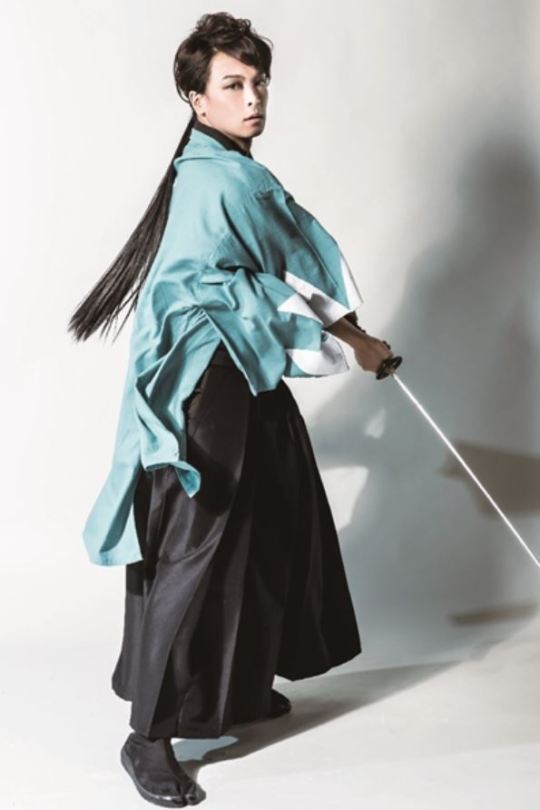
Tabuchi Noriaki as Serizawa Kamo (芹沢鴨)
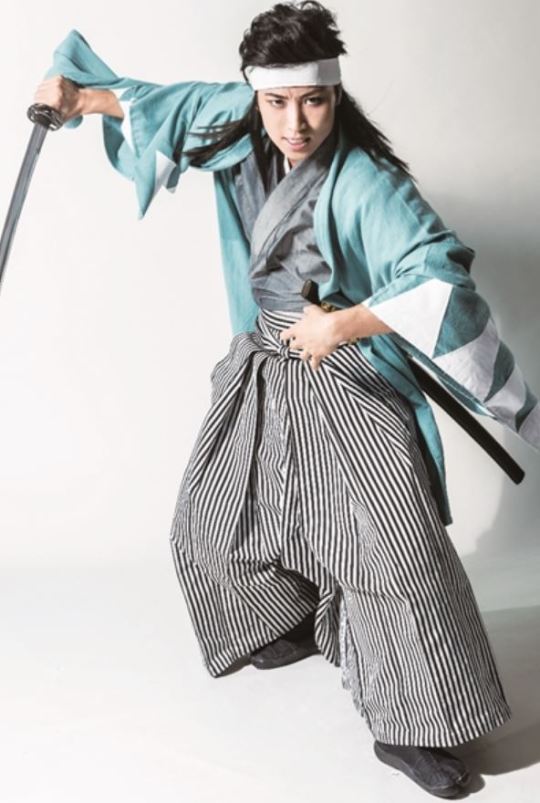
Yamamoto Masahiro as Kondou Isami (近藤勇)

Ishida Naoya as Yamanami Keisuke (山南敬助)
Aoki Takeshi as Inoue Genzaburou (井上源三郎) Kuroda Yousuke as Nagakura Shimpachi (永倉新八) Ikenoue Yoritsugu as Toudou Heisuke (藤堂平助) Nakauchi Tanma as Saitou Hajime (斎藤一) Harada Kenji as Niimi Nishiki (新見錦) Fujii Toshinari as Hirama Juusuke (平間重助) Matsuda Hiroki as Tachikawa Chikara (立川主税) Iida Torayoshi as Okuzawa Eisuke (奥沢栄助) Shin Masatoshi as Nakaoka Shintarou (中岡慎太郎) (終ノ章のみ) Umebayashi Ryouta as Matsudaira Katamori / Kiyokawa Hachirou (松平容保 / 清河八郎) Yamamoto Kenji as Kido Takayoshi (桂小五郎) Suzumura Chikao as Enomoto Takeaki (榎本武揚)(終ノ章のみ) Ueda Ryou as Kusaka Genzui (久坂玄瑞) Nagano Tasuku as Mochizuki Kameyata (望月亀弥太) Ikeda Reo as Kitazoe Litsuma (北添佶麿) Kaneko Ryouta as Miyabe Teizou (宮部鼎蔵) Ogawa Takeru as Boy (少年) Hara Akiko as Akari / Oume (あかり / お梅)

Tomimori Justin as Ito Kashitarou (伊東甲子太郎)(終ノ章のみ) Arai Shou as Harada Sanosuke (原田左之助) Doi Taiji as Okada Izou (岡田以蔵)
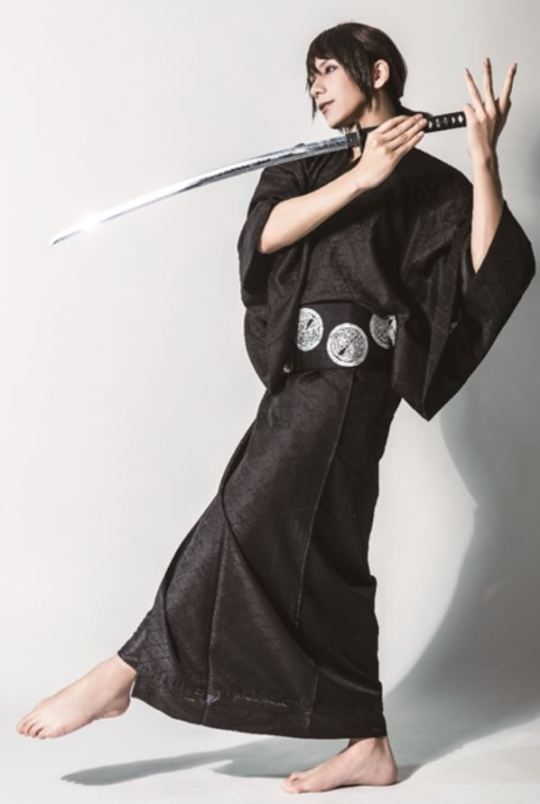

Matsuda Gaku as Yoshida Toshimaro / Sakamoto Ryouma (吉田稔麿 / 坂本龍馬)
homepage twitter sumabo
#新選組#shinsengumi#鐘ヶ江洸#kanegae kou#田中尚輝#tanaka naoki#田渕法明#tabuchi noriaki#山本誠大#yamamoto masahiro#石田直也#ishida naoya#青木威#aoki takeshi#黒田陽介#kuroda yousuke#池之上頼嗣#ikenoue yoritsugu#中内天摩#nakauchi tenma#原田賢治#harada kenji#藤井惇成#fujii toshinari#松田大輝#matsuda hiroki#飯田寅義#iida torayoshi#新正俊#shin masatoshi
11 notes
·
View notes
Photo
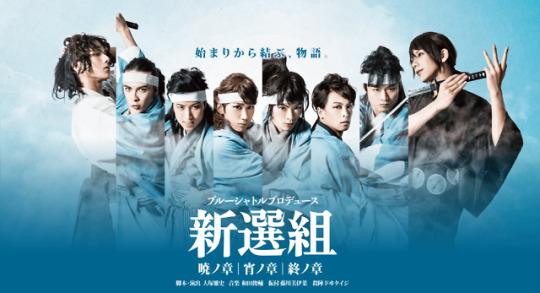
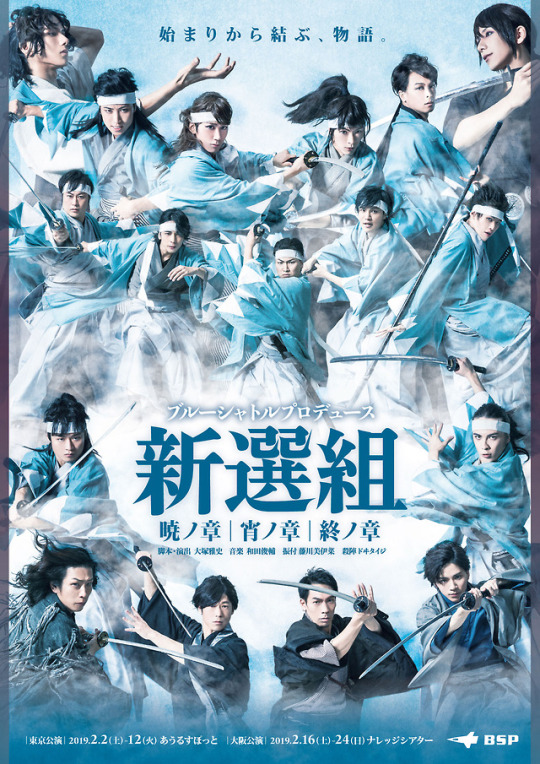
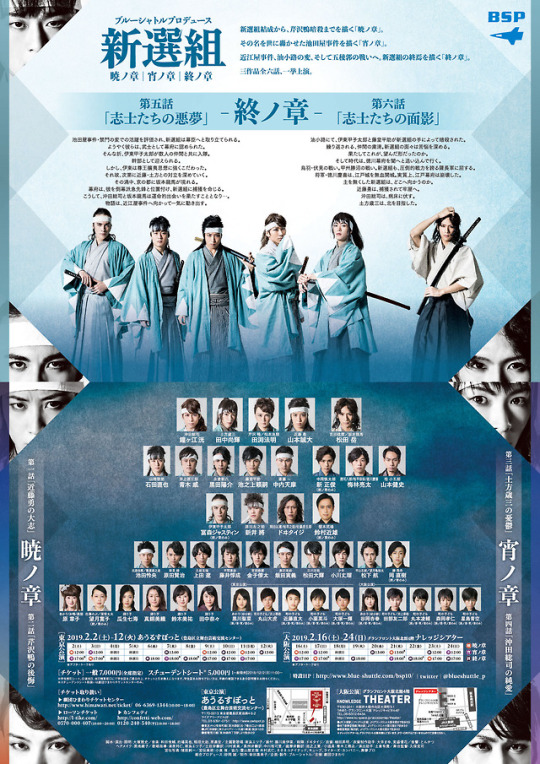
ブルーシャトルプロデュース 「『新選組』完結編」 Shinsengumi Kanketsuhen Shinsengumi: Concluding Chapter
Tokyo 2019.02.02-12 Owl Spot Osaka 2019.02.16-24 Knowledge Theater
HP: http://www.blue-shuttle.com/bsp10/
暁ノ章 / Akatsuki no Shou (Dawn chapter) 「近藤勇の大志」 Kondou Isami no Taishi (The Ambition of Kondou Isami) 「芹沢鴨の後悔」 Serizawa Kamo no Koukai (The Regret of Serizawa Kamo)
宵ノ章 / Yoi no Shou (Evening chapter) 「土方歳三の憂鬱」 Hijikata Toshizou no Yuuutsu (The Melancholy of Hijikata Toshizou) 「沖田総司の純愛」 Okita Souji no Jun'ai (The Pure Love of Okita Souji)
終ノ章 / Tsui no Shou (Final chapter) 「志士たちの悪夢」 Shishi-tachi no Akumu (The Patriots' Nightmare) 「志士たちの面影」 Shishi-tachi no Omokage (The Patriots' Trace)
CAST: Kanegae Kou - Okita Souji Tanaka Naoki - Hijikata Toshizou Tabuchi Noriaki - Serizawa Kamo, Matsumoto Ryoujun Yamamoto Masahiro - Kondou Isami Matsuda Gaku - Yoshida Toshimaro, Sakamoto Ryouma
Ishida Naoya - Yamanami Keisuke Aoki Takeshi - Inoue Genzaburou Kuroda Yousuke - Nagakura Shinpachi Arai Shou - Harada Sanosuke Ikenoue Yoritsugu - Toudou Heisuke Nakauchi Tenma - Saitou Hajime Harada Kenji - Niimi Nishiki Fujii Atsunari - Hirama Juusuke Matsushita Wataru - Hirayama Gorou, Mochizuki Kameyata Matsuda Taiki - Tachikawa Chikara Iida Torayoshi - Okuzawa Eisuke Umebayashi Ryouta - Matsudaira Katamori, Kiyokawa Hachirou, Tokugawa Yoshinobu Yamamoto Kenji - Katsura Kogorou Ueda Ryou - Kusaka Genzui Ikeda Reo - Kitazoe Kitsuma, Shinohara Tainoshin Kaneko Ryouta - Miyabe Teizou Ogawa Takeru - a boy Hara Akiko - Akari, Oume, Black cat Doi Taiji - Okada Izou, Katsura Hayanosuke, Satou Hikogorou
"Tsui no Shou" only: Tomimori Justin - Itou Kashitarou Suzumura Chikao - Enomoto Takeaki Shin Masatoshi - Nakaoka Shintarou Oka Naoki - Katsu Kaishuu Mochizuki Hiroko - Satou Nobu, Miyuki tayuu
STAFF: Director: Ootsuka Masashi Music: Wada Shunsuke Choreography: Fujikawa Miina
4 notes
·
View notes
Text
Character vs. actor ages at the beginning of the drama:
A list comparing the ages of historical personas in 1854 and actors in 2004. I’m using the year the story starts, not the year the drama opens up with (1864). Hopefully I’ve calculated everything correctly!
Shinsengumi
Shingo Katori/Kondo Isami: 27/20
Koji Yamamoto/Hijikata Toshizo: 28/19
Tatsuya Fujiwara/Okita Souji: 22/10 (or 12 if born in 1842)
Joe Odagiri/Saito Hajime: 28/10
Nakamura Kantaro II/Todo Heisuke: 23/10
Taro Yamamoto/Harada Sanosuke: 30/14
Masato Sakai/Yamanami Keisuke: 31/21 (or 19 if born in 1835)
Tomomitsu Yamaguchi/Nagakura Shinpachi: 35/15
Takashi Kobayashi/Inoue Genzaburo: 45/25
Shoei/Shimada Kai: 30/26
Koji Ohkura/Kawai Kisaburo: 30/16
Seichū-rōshi gumi
Koichi Sato/Serizawa Kamo: 44/24
Kazuyuki Aijima/Niimi Nishiki: 43/18
Itō-dōjō party
Shosuke Tanihara/Ito Kashitaro: 32/19
Aizu Domain
Michitaka Tsutsui/Matsudaira Katamori: 33/18
Tosa Domain
Yosuke Eguchi/Sakamoto Ryoma: 37/18
Chōshū Domain
Ken Ishiguro/Kido Takayoshi: 38/21
Hiroyuki Ikeuchi/Kusaka Genzui: 28/14
Satsuma Domain
Takashi Ukaji/Saigo Takamori: 42/26
Tokugawa shogunate
Noda Hideki/Katsu Kaishu: 49/31
Tetsushi Tanaka/Matsumoto Ryojun: 38/22
Others
Koji Ishizaka/Sakuma Shozan: 63/43
Jay Kabira/Henry Heusken: 42/22
(I’m using the Shinsengumi no Makoto page/Wikipedia as a birthdate source. Names are written as stated on Wikipedia.)(I didn’t include the girls because I have no idea where to find the dates?? I’ll update if I do. Some people have no dates listed so they’re not mentioned and some people arent there because there is simply too many of them and I get lazy XD)
7 notes
·
View notes
Text
Niimi Nishiki
Niimi Nishiki (1836-1863)
He belongs to Serizawa's group and is a master (Menkyo Kaiden) of the Shinto Munen Ryu like Serizawa. He is thought to be from the Mito area like Serizawa and was said to be Serizawa's right hand man. At one point he was also a commander but apparently got demoted to Vice-Commander. He was said to be forced to commit hara-kiri a few months before September by Kondou's faction in a shop called Yamanoo in Gion, for violation of rules. However there is no record. There is an alternate theory that he was a Choshu spy by the name of "Iori Tanaka", who was killed at around the same time and was assumed as Niimi. His grave is in Mibudera, Kyoto.
0 notes
Photo




Character challenges continuing.
#hakuouki#nagumo kaoru#nagakura shinpachi#niimi nishiki#takeda kanryusai#harada sanosuke#toudou heisuke#sannan keisuke#iba hachiro#ngl I loved drawing little kaoru#so cute ^_^#still trying to figure out how muscles work..#I counted that there's about 12 musicals#not all feature kinniku love though#even with help of google I'm still not sure what abaft is#even less idea how to use it#iba's hair is pain to draw#well practice practice#character challenge#fan art
62 notes
·
View notes
Photo

next sign meme
138 notes
·
View notes
Photo






A collection of my favourite pictures of characters who only have one actor.
Source: hakumyu-fancom.livejournal.com
#Shiramata Atsushi#Kubodera Akira#Shinozaki Kouki#Ibuki Ryunosuke#Serizawa Kamo#Niimi Nishiki#Hakumyu
0 notes
Text
Fan Account: ai-da-ice at Chiruran Shinsengumi Requiem
When I found out Toru and Sota would be having their stage debut with an adaptation of the manga series “Chiruran Shinsengumi Requiem,” I knew I had to go. I was of course anxious about the level of my Japanese and how much of the story I’d be able to understand on my own, but nothing could make me too anxious to pass up the chance to see two precious members of my favorite group hone and display their acting skills. So as soon as ticketing opened up, I purchased a ticket to see the play on April 25 at 7 pm at the Tennzou Galaxy Theater.

Doors for the venue, a very lovely theater located within Sea Fort (a hotel/shopping center hybrid) opened at 6:30. I cut it EXTREMELY close because my bad luck struck again and I wound up taking the wrong train line and having to splurge for a taxi to get me to the right location in time for the show. Luckily, I had just enough time to make it to the merch table to snag some goods with whatever I had left from paying the taxi fare. The goods for sale included a program, photo sets of the actors, pins, and a poster (which sold out right away). I bought the program and one of my Sota’s photosets. I would have bought Toru’s as well, but I was unfortunately short on cash.

After, I went inside the venue to take my seat. I was in the sixth row to the left of the stage, so I had an excellent view. Finally, some good luck after getting the worst lottery ticket at the FlowBack event and missing the lotto at Da-iCE’s Stickyle event!

The show started quite promptly. I don’t want to spoil too much about the story since I believe there is going to be an anime series upcoming, but to sum up: The story starts in 1859, a few years before the foundation of the Shinsengumi police force. Hijikata Toshizo (Sota) works as a peddler of medicine but aims to become a stronger swordsman. When he hears of the Shieikan dojo run by Kondo Isami (played by Eiji Takigawa), he decides to challenge him and prove his strength. He’s quickly defeated, but Kondo admires his belief that a man should aim to become the strongest, and invites him to continue to train at the dojo. Hijikata works to build his strength there alongside fellow swordsmen Okita Souji (Toru), Saito Hajime (Yuki Saotome),Sannan Keisuke (Izumi Souji), and Nagakura Shinpachi (Shion Tsuchiya), all of whom would also become members of the Shinsengumi in the future. However, the men of the Shieikan dojo face a seemingly insurmountable conflict when they face off against the leaders of a rival group, Serizawa Kamo (Toshio Matsumoto) and Niimi Nishiki (Masakazu Nemoto), who may also have ties to the mysterious female warrior Hijikata meets in battle.
The story of Chiruran was very diverse-- there were hilarious moments, tense moments, and heartbreaking moments, and of course lots of fighting. My favorite parts involved the swordfights, which were beautifully choreographed and executed by the actors. I know Sota and Toru both worked hard on these aspects, and both of them did a fantastic job. Toru in particular had some epic moments because his character, Okita, has a dual personality, and one side involves him completely snapping, chanting “Kill, kill, kill” and absolutely massacring who he’s fighting. Toru did a fantastic job with the fighting in those scenes, and I was very impressed by him.
Both boys did a great job with their acting as well. Sota was arguably the show’s main character and had the chance to show multiple sides of his character ranging from stubbornly hotheaded and fiercely determined to heart rendingly emotional as the conflicts he’s involved in begin hurting the people he cares about. Toru’s role also involved one of the most heartbreaking moments of the night, and I feel like he portrayed it beautifully-- when he lifted his head, you could even see the real tear streaks on his face.
My Japanese is of course still very lacking, but I felt I was able to understand he key points of the story, thanks in part to my familiarity with the Shinsengumi. It was a bit challenging at points because the characters were yelling a lot (naturally, as samurai), which was a bit harder for me to understand, but I was able to follow along well enough considering. I had a fantastic time!
At the conclusion of the show, all the actors came together and did the traditional closing bow for us. For the final bow, we were allowed to take our cameras out and quickly snap a few shots. I hadn’t been aware of this, so I had to do a manic lunge and grab for my camera, but I managed to get a few shots before the curtain fell again, though I’m afraid thanks to my rush and hand tremor, they’re a little blurry T^T. Here’s one, an example, I’ll post the rest separately:

After the event, I had read online that we would have the opportunity to greet some of the cast in the lobby, so were asked to leave the theater by our rows. Since I was the sixth row, I was allowed to leave fairly early. I was already freaking out because it was possible Toru and Sota could be among the cast members, so by time I was out, my heart was pounding. I saw Izumi Souji first, and he bowed to me, so I was panicking for a moment (should I bow back? Yes, probably since the girl in front of me had?), so I forgot to look at the rest of the cast for a moment. When I had finished my pitiful bow, I looked up and saw Sota Hanamura looking at me and completely froze like a deer in the headlights. And then, right next to him was Toru and my brain turned into a complete mess of “Oh my god, they’re here, what should I do?”
Sota said “Arigatou” to me in Japanese first, then added “Hello, thank you” in English after. Toru waved and said “Hello, thank you for your support!” in English. Naturally, my brain was now exploding in fireworks, so I’m not really what I did or said back, if anything. I think I maybe waved back or did some kind of weird gesture, and I may have either said Arigatou or thank you back, but I may have just squeaked, I honestly have no recollection. I was just so happy to see them again, and hear them speak to me in English after a year ago in San Jose. And so my proud tradition of not being able to say anything to my idols whether Japanese, Korean, or American in person continues! Still, I was so happy just to see them again, that it doesn’t matter. I went back to the train in a blaze of euphoria!
And that was my Chiruran experience!
16 notes
·
View notes
Text

Shinsengumi The Shinsengumi (New Selected Group”) was a special police force organized by the Bakufu (military government) during Japan’s Bakumatsu period (late Tokugawa shogunate) in 1864. It was active until 1869.

Rōshigumi. The Tokugawa shogunate formed the Rōshigumi (“the rōnin squad”) on October 19, 1863. The Rōshigumi was a squad of 234 rōnin (samurais without masters) from the sword schools of Edo.
Mibu Rōshigumi mean wolf Thirteen Rōshigumi members, mainly from the Mito clan, remained and formed the Mibu Rōshigumi. The Mibu Rōshigumi were called Miburō-“rōnin of Mibu”. At the time, Mibu was a village south west of Kyoto, and was the place where they were stationed. In August 18, 1863, the Mibu Rōshigumi was renamed the Shinsengumi (“New Selected Group”).

Shinsengumi The Shinsengumi were led by Serizawa Kamo, Niimi Nishiki, and Kondō Isami and it formed three factions under Serizawa (the Mito group), Kondō (the Shieikan group) and Tonouchi. There were disagreements and tensions in the group and it bring coflict among them. Matsudaira Katamori of Aizu giving the Shinsengumi an order to assassinate Serizawa and was killed on Yojō bridge. Serizawa ordered Iesato Tsuguo, to commit seppuku for deserting. Only left Kondō as leader of Shinsengumi. The Shinsengumi submitted a letter to the Aizu clan, powerful group who supported the Tokugawa regime, requesting their permission to police Kyoto. The request was granted by them. In 1864, in an incident at the Ikedaya Inn, Kyoto, thirty Shinsengumi suppressed a cell of twenty Chōshū revolutionaries, possibly preventing the burning of Kyoto. The incident made the squad more famous and led to soldiers enlisting in the squad.
Founding members: Serizawa’s faction: Serizawa Kamo, Niimi Nishiki, Hirayama Gorō, Hirama Jūsuke, Noguchi Kenji, Araya Shingorō, Saeki Matasaburō Kondō’s faction: Kondō Isami, Hijikata Toshizō, Inoue Genzaburō, Okita Sōji, Nagakura Shinpachi, Saitō Hajime, Harada Sanosuke, Tōdō Heisuke, Sannan Keisuke Tonouchi’s faction: Tonouchi Yoshio, Iesato Tsuguo, Abiru Aisaburō, Negishi Yūzan Squad: Commander (Kyokuchō): Kondō Isami, fourth master of the Tennen Rishin-ryū, General Commander (Sōchō): Sannan Keisuke Vice Commander (Fukuchō): Hijikata Toshizō Military Advisor (Sanbō): Itō Kashitarō Spies: Shimada Kai and Yamazaki Susumu. Troop Captains (Kumichō): Okita Sōji (instructor in Kenjutsu), Nagakura Shinpachi (instructor in Kenjutsu), Saitō Hajime (instructor in Kenjutsu), Matsubara Chūji (instructor in Jujutsu), Takeda Kanryūsai (instructor in military strategies), Inoue Genzaburō, Tani Sanjūrō (instructor in spearing skills), Tōdō Heisuke, Suzuki Mikisaburō, Harada Sanosuke.
The new emperor had been named the head of a new government (meaning the end centuries of military rule by the shōguns) in year 1867 and this marked the beginning of the Boshin civil war. The Shinsengumi fought in the Battle of Toba–Fushimi. Kondō suffered a gunshot wound but went on to fight at the Battle of Kōshū-Katsunuma. He was then captured in Nagareyama. he was declared guilty of participation in the assassination of Sakamoto Ryōma and was beheaded in Itabashi. The Shinsengumi fought in defense of Aizu territory under Saitō Hajime and joined the forces of the Republic of Ezo in the north. Hijikata led a daring but doomed raid to steal the imperial warship Kōtetsu. Hijikata’s death from a gunshot wound on June 20 1869, in Hokkaido, made the end of the Shinsengumi. Another group surrendered separately. Only survived the war: Nagakura Shinpachi, Saitō Hajime, and Shimada Kai and Takagi Teisaku to become prominent figures.

Shinsengumi regulations was created by Hijikata Toshizō and Kamo Serizawa or Isami Kondō. It prohibiting deviation from the samurai code (Bushido).
Uniform: Following the orders of the Shinsengumi commander Serizawa Kamo, the standard uniform consisted of the haori and hakama over a kimono, with a white cord called a tasuki crossed over the chest and tied in the back. The function of the tasuki was to prevent the sleeves of the kimono from interfering with movement of the arms. The Shinsengumi wore a light chainmail suit beneath their robes and a light helmet made of iron. The uniform was best defined by the haori, which was colored asagi-iro (light blue). They uniform stand out from enemies.
—Shinsengumi— Shinsengumi The Shinsengumi (New Selected Group") was a special police force organized by the Bakufu (military government) during Japan's Bakumatsu period (late Tokugawa shogunate) in 1864.
0 notes